Optical Design of a Novel Two-Stage Dish Applied to Thermochemical Water/CO2 Splitting with the Concept of Rotary Secondary Mirror
Abstract
1. Introduction
2. Optical Model
2.1. Prototype of TSD Concentrator
2.2. Prototype of Reactor
2.3. Truncated SM
3. Validation
4. Results and Discussion
5. Conclusions
- (1)
- A new concept of a two stage dish concentrator is proposed to achieve successive thermochemical solar fuel production, consisting of a conventional paraboloid dish and a unique off-axis rotary secondary hyperboloid reflector;
- (2)
- The shape of the SM is optimized by a new mathematical model. Compared to the original design, the optical performance can further be improved by using an optimal truncated SM in off-axis conditions. This helps to achieve a good optical performance, when a large inclination angle is required;
- (3)
- The best solutions corresponding to the largest optical efficiencies fall in the ranges of π/2 ≤ φ1 ≤ (π − arcsin 0.8) rads, and 0.4 ≤ NA2 ≤ 0.6, which may vary with the concentration ratio and inclination angle. The scale of the configurations had no effect on the results except for the intercepted radiant flux. This characteristic makes the scale up/down calculation much easier.
Author Contributions
Funding
Acknowledgments
Conflicts of Interest
References
- Blanco, M.; Santigosa, L.R. Advances in Concentrating Solar Thermal Research and Technology; Woodhead: Cambridge, UK, 2016. [Google Scholar] [CrossRef]
- Lipiński, W.; Davidson, J.; Haussener, S.; Klausner, J.; Mehdizadeh, A.; Petrasch, J.; Steinfeld, A.; Venstrom, L. Review of heat transfer research for solar thermochemical applications. J. Therm. Sci. Eng. Appl. 2013, 5, 021005. [Google Scholar] [CrossRef]
- Meier, A.; Steinfeld, A. Solar thermochemical production of fuels, Advances in Science and Technology. Adv. Sci. Technol. 2010. [Google Scholar] [CrossRef]
- Kodama, T.; Gokon, N. Thermochemical cycles for high-temperature solar hydrogen production. Chem. Rev. 2007, 107, 4048–4077. [Google Scholar] [CrossRef] [PubMed]
- Romero, M.; Steinfeld, A. Concentrating solar thermal power and thermochemical fuels. Energy Environ. Sci. 2012, 5, 9234–9245. [Google Scholar] [CrossRef]
- Scheffe, J.R.; Steinfeld, A. Oxygen exchange materials for solar thermochemical splitting of H2O and CO2: A review. Mater. Today 2014, 17, 341–348. [Google Scholar] [CrossRef]
- Bader, R.; Chandran, R.B.; Venstrom, L.J.; Sedler, S.J.; Krenzke, P.T.; De Smith, R.M.; Banerjee, A.; Chase, T.R.; Davidson, J.H.; Lipiński, W. Design of a solar reactor to split CO2 via isothermal redox cycling of ceria. J. Sol. Energy Eng. 2015, 137, 031007. [Google Scholar] [CrossRef]
- Steinfeld, A. Solar hydrogen production via a two-step water-splitting thermochemical cycle based on Zn/ZnO redox reactions. Int. J. Hydrogen Energy 2002, 27, 611–619. [Google Scholar] [CrossRef]
- Perkins, C.; Lichty, P.R.; Weimer, A.W. Thermal ZnO dissociation in a rapid aerosol reactor as part of a solar hydrogen production cycle. Int. J. Hydrogen Energy 2008, 33, 499–510. [Google Scholar] [CrossRef]
- Loutzenhiser, P.G.; Meier, A.; Steinfeld, A. Review of the two-step H2O/CO2-splitting solar thermochemical cycle based on Zn/ZnO redox reactions. Materials 2010, 3, 4922–4938. [Google Scholar] [CrossRef]
- Abanades, S.; Charvin, P.; Lemont, F.; Flamant, G. Novel two-step SnO2/SnO water-splitting cycle for solar thermochemical production of hydrogen. Int. J. Hydrogen Energy 2008, 33, 6021–6030. [Google Scholar] [CrossRef]
- Kodama, T.; Kondoh, Y.; Yamamoto, R.; Andou, H.; Satou, N. Thermochemical hydrogen production by a redox system of ZrO2-supported Co (II)-ferrite. Sol. Energy 2005, 78, 623–631. [Google Scholar] [CrossRef]
- Scheffe, J.R.; McDaniel, A.H.; Allendorf, M.D.; Weimer, A.W. Kinetics and mechanism of solar-thermochemical H2 production by oxidation of a cobalt ferrite–zirconia composite. Energy Environ. Sci. 2013, 6, 963–973. [Google Scholar] [CrossRef]
- Allendorf, M.D.; Diver, R.B.; Siegel, N.P.; Miller, J.E. Two-step water splitting using mixed-metal ferrites: Thermodynamic analysis and characterization of synthesized materials. Energy Fuels 2008, 22, 4115–4124. [Google Scholar] [CrossRef]
- Chueh, W.C.; Haile, S.M. A thermochemical study of ceria: Exploiting an old material for new modes of energy conversion and CO2 mitigation. Philos. Trans. R. Soc. Lond. A Math. Phys. Eng. Sci. 2010, 368, 3269–3294. [Google Scholar] [CrossRef] [PubMed]
- Furler, P.; Scheffe, J.; Gorbar, M.; Moes, L.; Vogt, U.; Steinfeld, A. Solar thermochemical CO2 splitting utilizing a reticulated porous ceria redox system. Energy Fuels 2012, 26, 7051–7059. [Google Scholar] [CrossRef]
- Hao, Y.; Yang, C.-K.; Haile, S.M. High-temperature isothermal chemical cycling for solar-driven fuel production. Phys. Chem. Chem. Phys. 2013, 15, 17084–17092. [Google Scholar] [CrossRef]
- McDaniel, A.H.; Miller, E.C.; Arifin, D.; Ambrosini, A.; Coker, E.N.; O’Hayre, R.; Chueh, W.C.; Tong, J. Sr-and Mn-doped LaAlO 3−δ for solar thermochemical H2 and CO production. Energy Environ. Sci. 2013, 6, 2424–2428. [Google Scholar] [CrossRef]
- Scheffe, J.R.; Weibel, D.; Steinfeld, A. Lanthanum–strontium–manganese perovskites as redox materials for solar thermochemical splitting of H2O and CO2. Energy Fuels 2013, 27, 4250–4257. [Google Scholar] [CrossRef]
- Mogensen, M.; Sammes, N.M.; Tompsett, G.A. Physical, chemical and electrochemical properties of pure and doped ceria. Solid State Ionics 2000, 129, 63–94. [Google Scholar] [CrossRef]
- Coker, E.N.; Ohlhausen, J.A.; Ambrosini, A.; Miller, J.E. Oxygen transport and isotopic exchange in iron oxide/YSZ thermochemically-active materials via splitting of C (18O)2 at high temperature studied by thermogravimetric analysis and secondary ion mass spectrometry. J. Mater. Chem. 2012, 22, 6726–6732. [Google Scholar] [CrossRef]
- Diver, R.B.; Miller, J.E.; Siegel, N.P.; Moss, T.A. Testing of a CR5 solar thermochemical heat engine prototype. ASME Paper 2010. [Google Scholar] [CrossRef]
- Furler, P.; Scheffe, J.R.; Steinfeld, A. Syngas production by simultaneous splitting of H2O and CO2 via ceria redox reactions in a high-temperature solar reactor. Energy Environ. Sci. 2012, 5, 6098–6103. [Google Scholar] [CrossRef]
- Ermanoski, I.; Siegel, N.P.; Stechel, E.B. A new reactor concept for efficient solar-thermochemical fuel production. J. Sol. Energy Eng. 2013, 135, 031002. [Google Scholar] [CrossRef]
- Lapp, J.; Davidson, J.H.; LipiĹ, W. Heat transfer analysis of a solid-solid heat recuperation system for solar-driven nonstoichiometric redox cycles. J. Sol. Energy Eng. 2013, 135, 031004. [Google Scholar] [CrossRef]
- Muhich, C.L.; Ehrhart, B.D.; Al-Shankiti, I.; Ward, B.J.; Musgrave, C.B.; Weimer, A.W. A review and perspective of efficient hydrogen generation via solar thermal water splitting. Wiley Interdiscip. Rev. Energy Environ. 2016, 5, 261–287. [Google Scholar] [CrossRef]
- Dähler, F.; Wild, M.; Schäppi, R.; Haueter, P.; Cooper, T.; Furler, P.; Steinfeld, A. A High-Flux Solar Parabolic Dish System for Continuous Thermochemical Fuel Production. Optics for Solar Energy; Optical Society of America: Boulder, CO, USA, 2017. [Google Scholar] [CrossRef]
- Rabl, A. Comparison of solar concentrators. Sol. Energy 1976, 18, 93–111. [Google Scholar] [CrossRef]
- Mauk, C.E.; Prengle, H.W.; Sun, E.C.-H. Optical and thermal analysis of a Cassegrainian solar concentrator. Sol. Energy 1979, 23, 157–167. [Google Scholar] [CrossRef]
- Zhang, Y.; Xiao, G.; Luo, Z.; Ni, M.; Yang, T.; Xu, W. Comparison of different types of secondary mirrors for solar application. Opt. Int. J. Light Electron Opt. 2014, 125, 1106–1112. [Google Scholar] [CrossRef]
- De la Mora, M.; Jaramillo, O.; Nava, R.; Tagüeña-Martínez, J.; del Río, J. Viability study of porous silicon photonic mirrors as secondary reflectors for solar concentration systems. Sol. Energy Mater. Sol. Cells 2009, 93, 1218–1224. [Google Scholar] [CrossRef]
- Feuermann, D.; Gordon, J.M. High-concentration photovoltaic designs based on miniature parabolic dishes. Sol. Energy 2001, 70, 423–430. [Google Scholar] [CrossRef]
- Segal, A.; Epstein, M. The optics of the solar tower reflector. Sol. Energy 2001, 69, 229–241. [Google Scholar] [CrossRef]
- Kribus, A.; Zaibel, R.; Segal, A. Extension of the hermite expansion method for cassegrainian solar central receiver systems. Sol. Energy 1998, 63, 337–343. [Google Scholar] [CrossRef]
- Feuermann, D.; Gordon, J.; Ries, H. High-flux solar concentration with imaging designs. Sol. Energy 1999, 65, 83–89. [Google Scholar] [CrossRef]
- Jiang, S.; Hu, P.; Mo, S.; Chen, Z. Optical modeling for a two-stage parabolic trough concentrating photovoltaic/thermal system using spectral beam splitting technology. Sol. Energy Mater. Sol. Cells 2010, 94, 1686–1696. [Google Scholar] [CrossRef]
- Wang, J.; Yang, S.; Jiang, C.; Yan, Q.; Lund, P.D. A novel 2-stage dish concentrator with improved optical performance for concentrating solar power plants. Renew. Energy 2017, 108, 92–97. [Google Scholar] [CrossRef]
- Yang, S.; Wang, J.; Lund, P.D.; Jiang, C. Assessing the impact of optical errors in a novel 2-stage dish concentrator using Monte-Carlo ray-tracing simulation. Renew. Energy 2018. [Google Scholar] [CrossRef]
- Buie, D.; Monger, A.; Dey, C. Sunshape distributions for terrestrial solar simulations. Sol. Energy 2003, 74, 113–122. [Google Scholar] [CrossRef]
- Lovegrove, K.; Burgess, G.; Pye, J. A new 500 m2 paraboloidal dish solar concentrator. Sol. Energy 2011, 85, 620–626. [Google Scholar] [CrossRef]
- Paitoonsurikarn, S.; Lovegrove, K. A new correlation for predicting the free convection loss from solar dish concentrating receivers. In Proceedings of the 44th Conference of the Australia and New Zealand Solar Energy Society, Canberra, Australia, 9–10 September 2006; Available online: http://hdl.handle.net/1885/38632 (accessed on 6 July 2020).

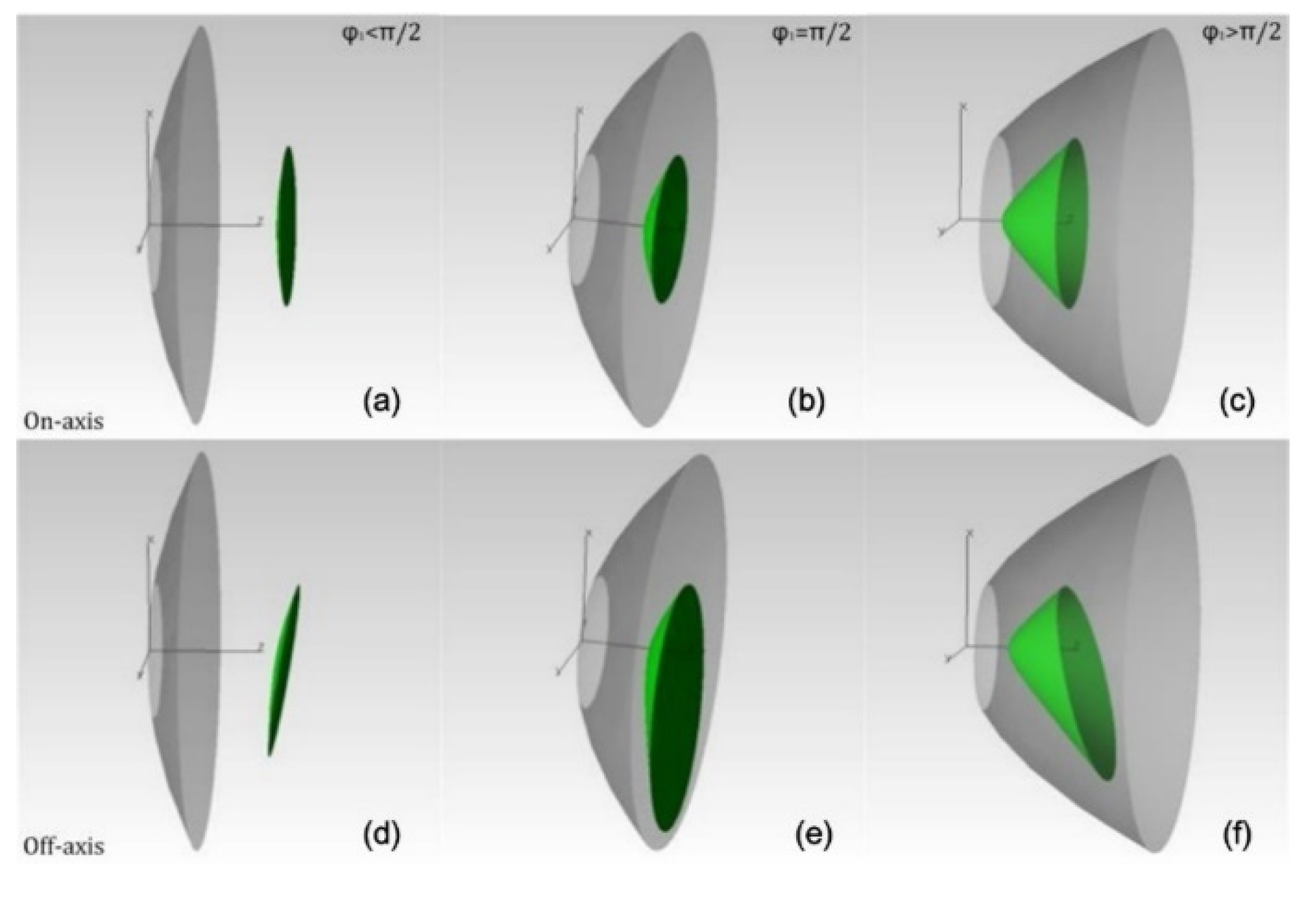
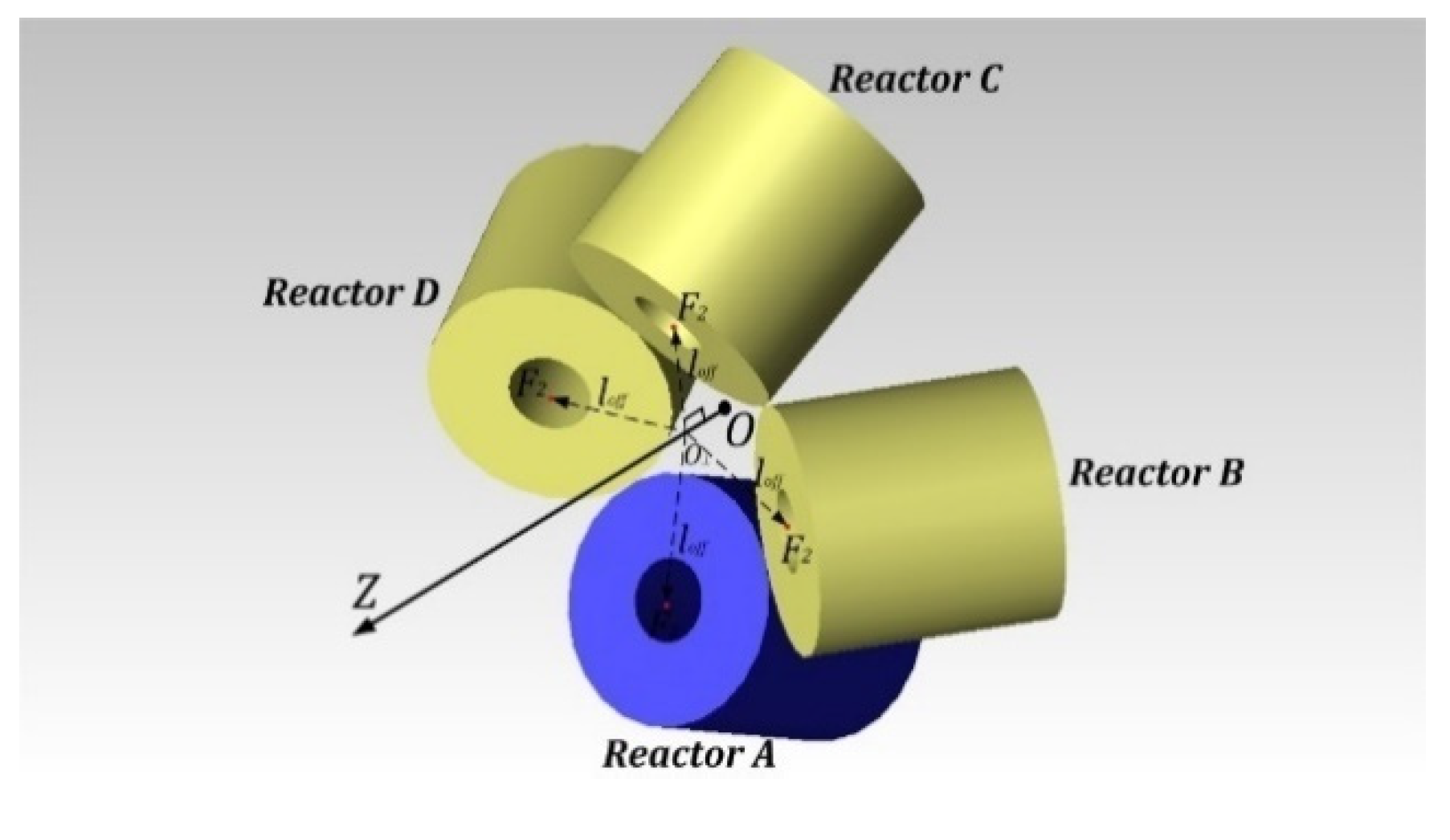

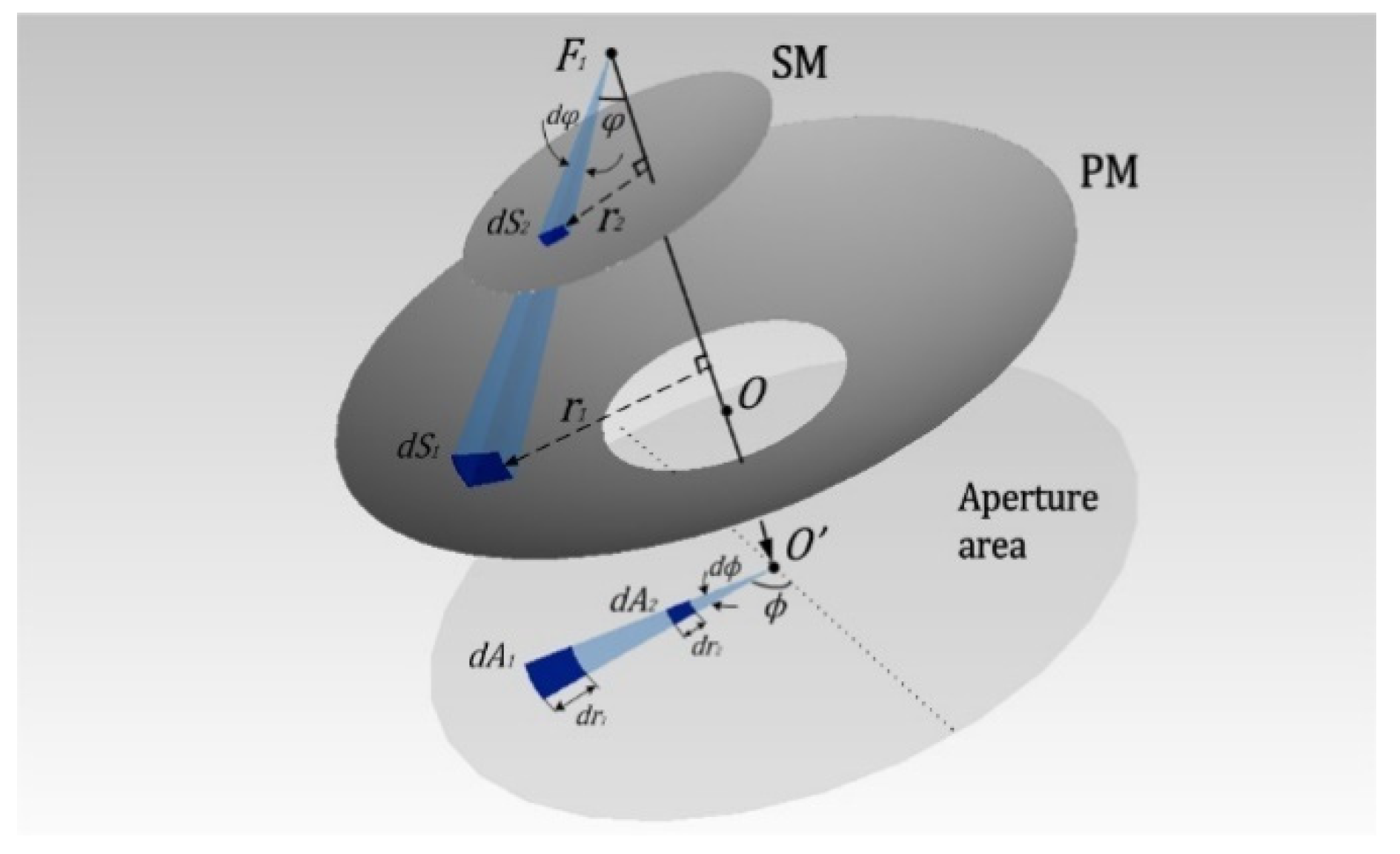
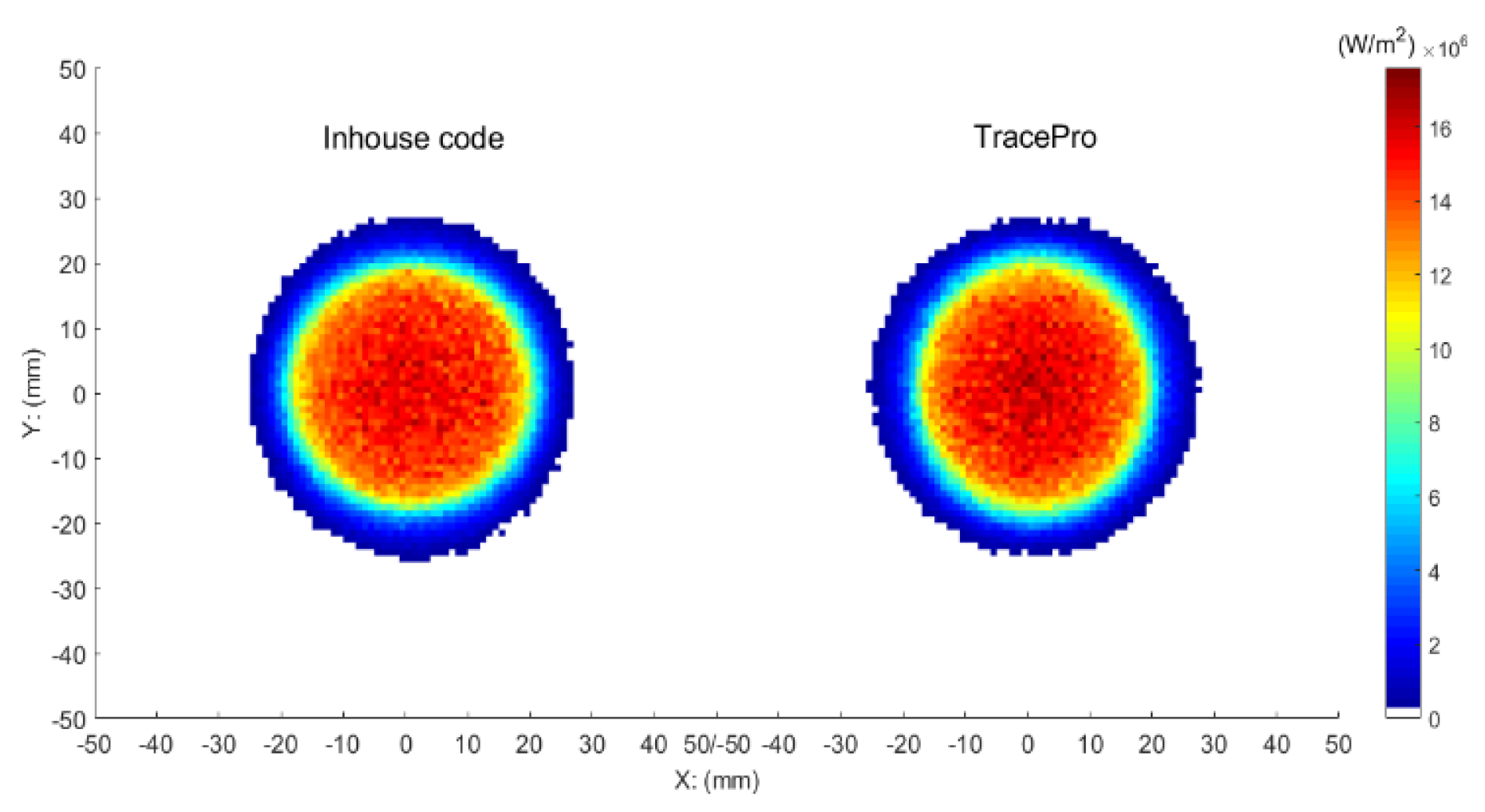
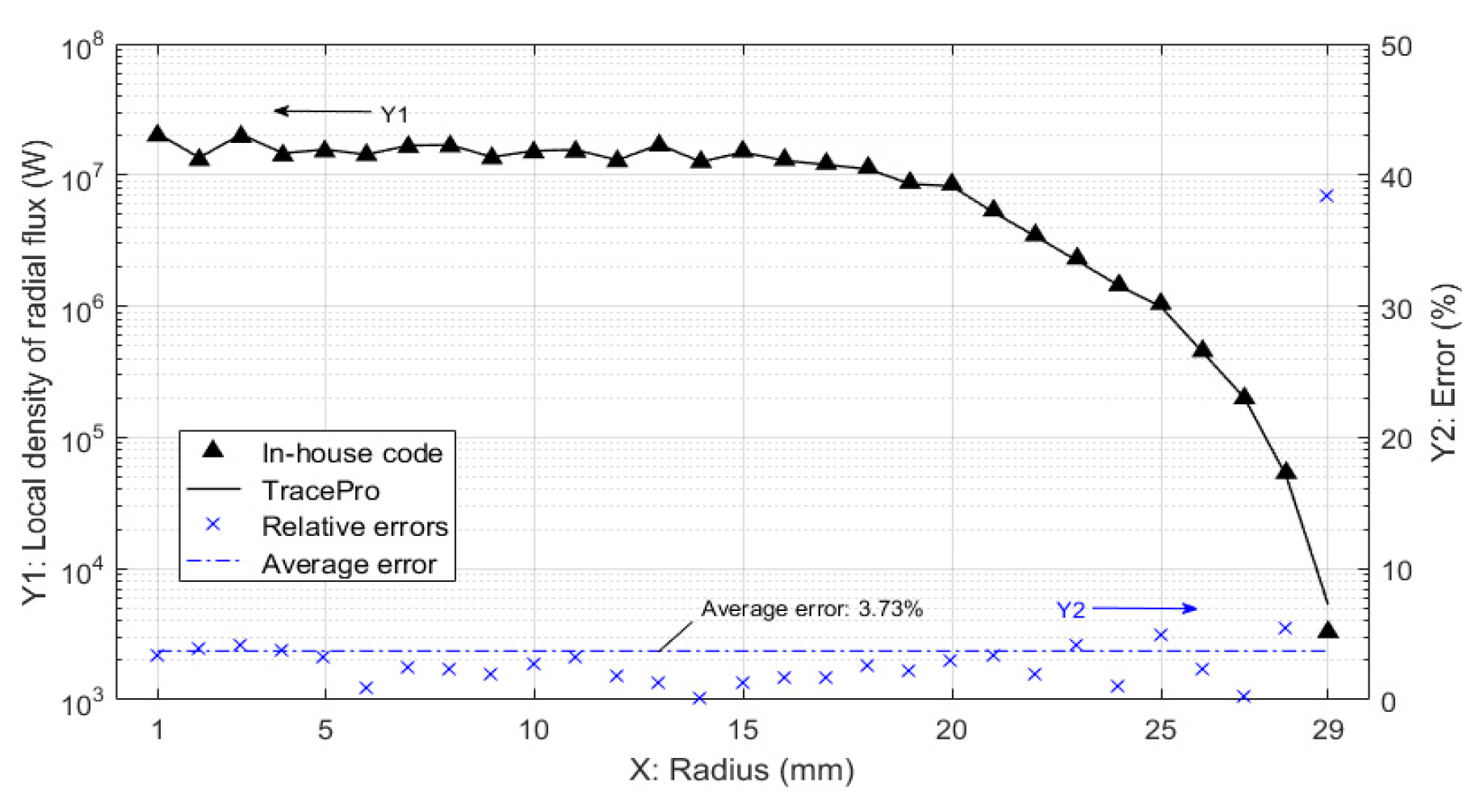
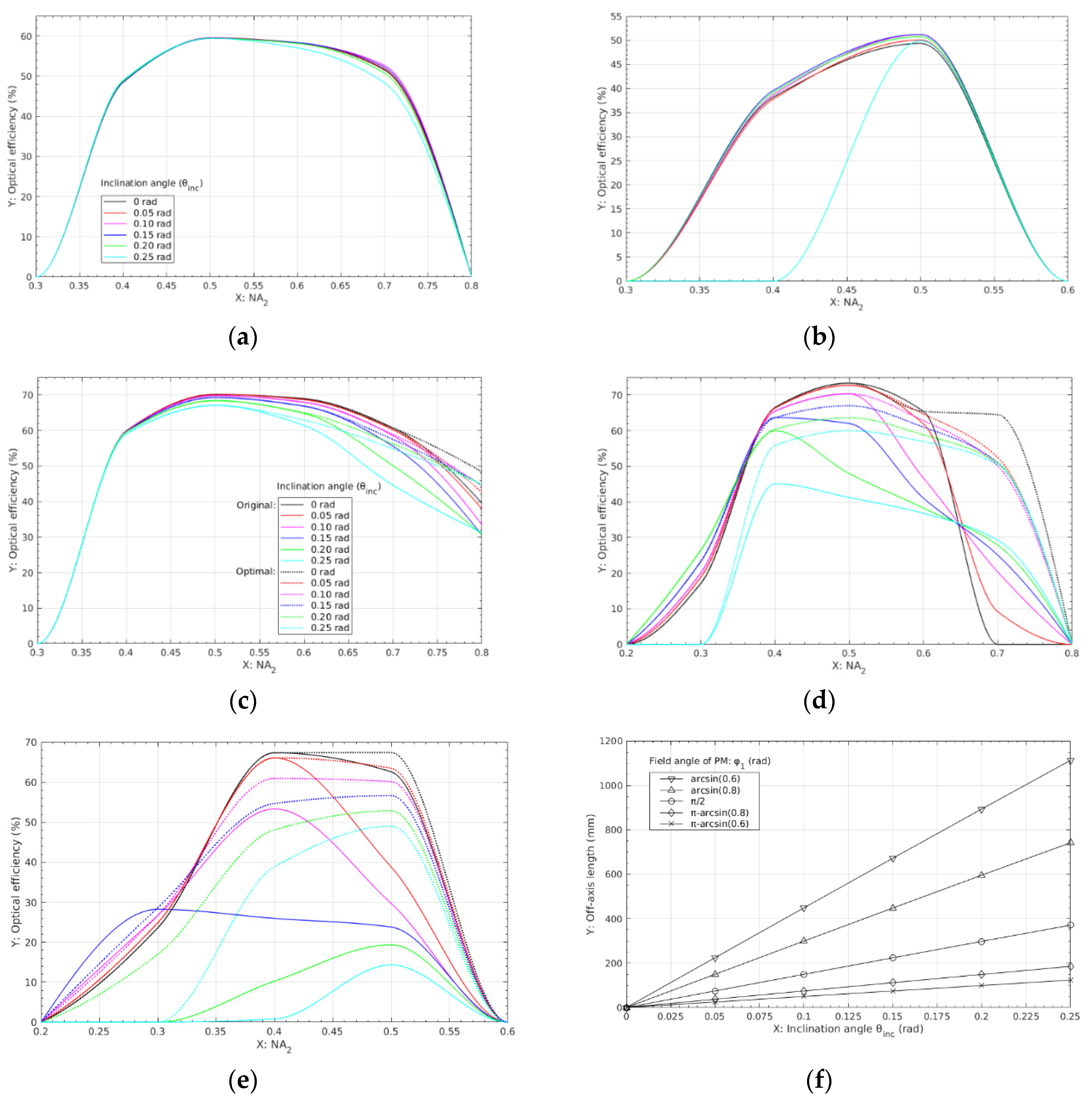
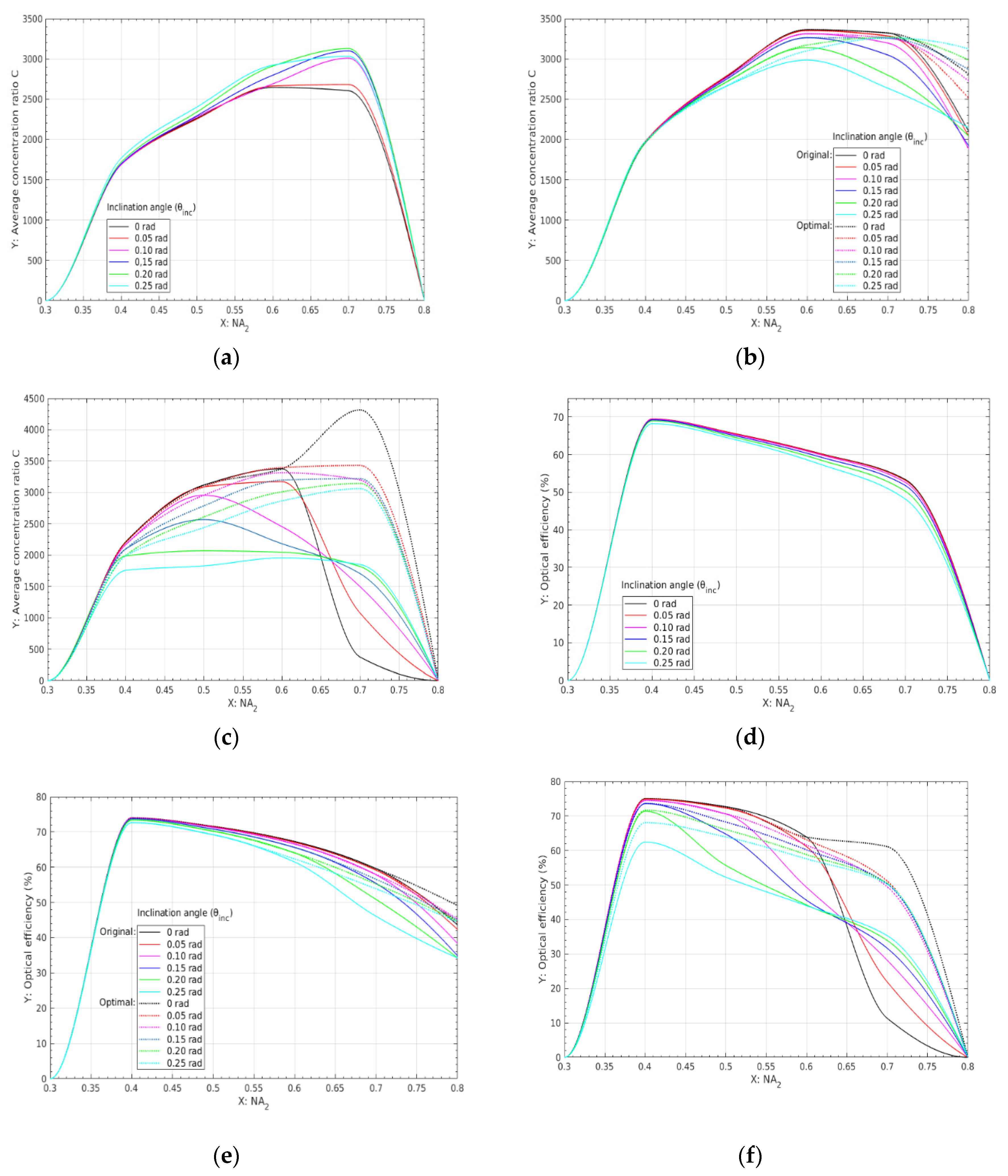


© 2020 by the authors. Licensee MDPI, Basel, Switzerland. This article is an open access article distributed under the terms and conditions of the Creative Commons Attribution (CC BY) license (http://creativecommons.org/licenses/by/4.0/).
Share and Cite
Yang, S.; Wang, J.; Lund, P.D. Optical Design of a Novel Two-Stage Dish Applied to Thermochemical Water/CO2 Splitting with the Concept of Rotary Secondary Mirror. Energies 2020, 13, 3553. https://doi.org/10.3390/en13143553
Yang S, Wang J, Lund PD. Optical Design of a Novel Two-Stage Dish Applied to Thermochemical Water/CO2 Splitting with the Concept of Rotary Secondary Mirror. Energies. 2020; 13(14):3553. https://doi.org/10.3390/en13143553
Chicago/Turabian StyleYang, Song, Jun Wang, and Peter D. Lund. 2020. "Optical Design of a Novel Two-Stage Dish Applied to Thermochemical Water/CO2 Splitting with the Concept of Rotary Secondary Mirror" Energies 13, no. 14: 3553. https://doi.org/10.3390/en13143553
APA StyleYang, S., Wang, J., & Lund, P. D. (2020). Optical Design of a Novel Two-Stage Dish Applied to Thermochemical Water/CO2 Splitting with the Concept of Rotary Secondary Mirror. Energies, 13(14), 3553. https://doi.org/10.3390/en13143553





